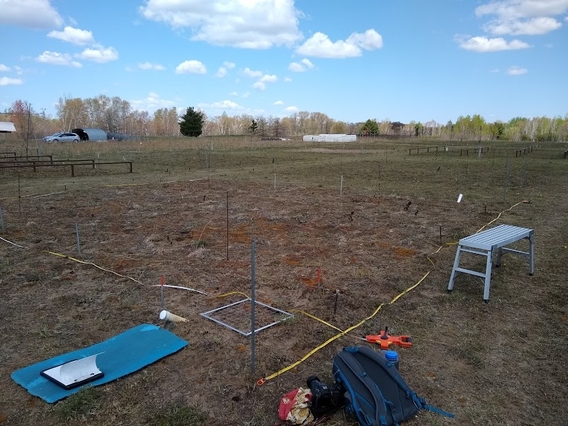
Ecologists have long observed that lichens, mosses and cyanobacteria are some of the first on the scene where other life is absent – such as where a glacier melts or lava cools. They build up nutrients before vascular plants take over, populating barren landscapes with life, a process known to the ecology world as “succession.” Despite their global prevalence and unique adaptive strategies, these bizarre organisms are often left out of the ecological paradigm. Mariana Cardenas is hoping to change that.
“It doesn’t matter where you go. Lichens and mosses are everywhere. In some ecosystems, they’re the dominant organisms. But even if they’re not, it doesn’t mean they’re not doing anything,” says Cardenas, a student in the Ecology, Evolution and Behavior Graduate program who recently released a paper in OIKOS highlighting her research at Cedar Creek Ecosystem Science Reserve.
These nonvascular photoautotrophs (NVPs) are not the dominant species of a prairie landscape, but they do exist – especially in disturbed prairies, like those that have been burned or abandoned by intensive agriculture. “I have the responsibility to put these pieces together to understand how things are changing and what we can do to mitigate the effects of global change on human populations. If we understand succession and predict what kinds of ecosystems we’re going to have in the future, we can be prepared.”
Scientists would love to know what kind of life will take the place of barren and disturbed landscapes – and how quickly. How will these drastically evolving ecosystems affect wildlife, the spread of disease and local food and water sources? Many windows of opportunity to study how succession occurs have already passed, but Cardenas is avidly pursuing existing opportunities we do have to prepare.

Succession at Cedar Creek
A major ingredient in the succession is time, which makes it challenging to study. And the conditions in which “primary” succession occurs are also often unpredictable, wild and remote – think volcanoes, the tundra, or mountain summits. Thankfully, the varied biodiversity in Cedar Creek’s “Big Biodiversity” experiment allows Cardenas to confidently examine the relationship between the vascular plants – grasses, herbaceous species – and the presence of lichens, mosses and cyanobacteria.
“I had a meeting with Professor David Tilman when I started working here and he explained to me that they’d never touched the [lichen and moss] communities in the [Big Biodiversity] experiment,” says Cardenas. Tilman set up the experiment in the 1980s and served as director of Cedar Creek for three decades. “That ended up being very good for me because I was going to be able to study 30 years of these organisms.”
The 30-year old plots are weeded annually to maintain a consistent number of native plant species, but everything else goes untouched. The results paint a nuanced picture of native biodiversity – not only are there plant species in the plots but a variety of other populations like fungi, bacteria, lichen and mosses that have shifted over time. “Sometimes I’ll go to a monoculture plot of a [native grassland] species and it will be thoroughly covered in moss,” says Cardenas. She laughs. “You can’t tell me this is a monoculture!”
In her results, she confirmed a pattern she suspected: mosses and lichens have a hard time competing for resources when plants are around. But in the case of cyanobacteria, she found the opposite.
Breaking down differences: a broader look at biodiversity
The nonvascular photoautotrophs – lichens, mosses and cyanobacteria – share an ecological niche, but biologically have lots of differences. Mosses are technically plants. Only they have no roots, no flowers and no specialized vascular system to deliver water and nutrients to their leafy tissue. Cyanobacteria aren’t plants at all; they’re a type of bacteria that can live in water and on land. And lichens? Every lichen is a combination of at least one fungi and one algae or cyanobacteria – together they function like a singular organism. So one could imagine how difficult it is to determine how each of their specialized traits might behave in their respective environments.

“Even if we consider all these nonvascular photoautotrophs [i.e. lichens, mosses and cyanobacteria] similar ecologically, they were affected in different ways. Cyanobacteria was something completely different. And we’re trying to figure out why.” They seem to be related to the levels of nitrates, NO2 and NO3 in the soil. Cardenas’ biggest takeaway has to do with how the available data at Cedar Creek is collected.
“What happens throughout the year matters. Seasonal organisms like cyanobacteria may peak during the spring when the snow melts and when plants still haven’t come up,” says Cardenas. She made her conclusions partly using 30 years of data collected seasonally by a large team of interns. They collect vascular plant biomass measurements at the peak of summer seasons.
“We designed these long-term field experiments to gather data primarily from the perspective of vascular plants, missing other biological factors that are happening,” says Cardenas. “Maybe this is something we need to change.” — Adara Taylor